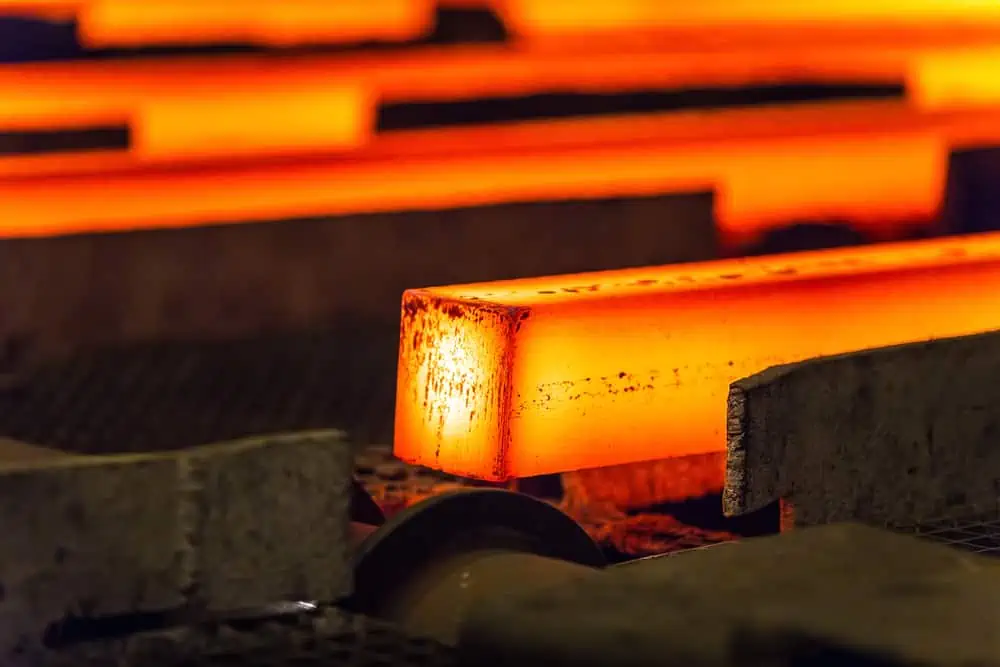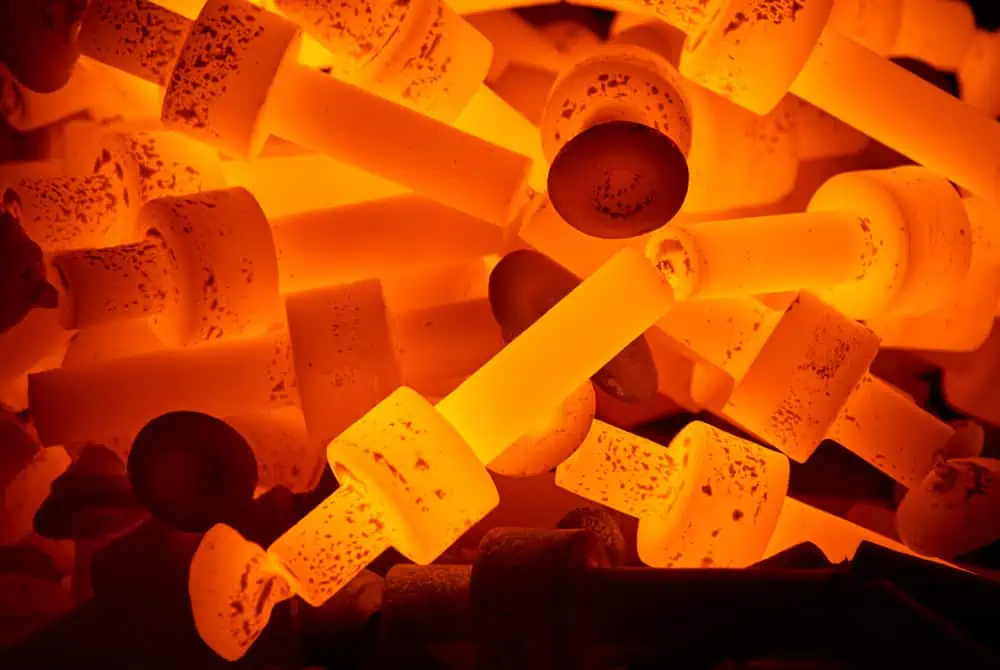Heat treatment is the process of heating and cooling metal in a controlled environment in order to modify its crystalline structure and mechanical properties to suit the intended application. There are many types of heat treatment processes applicable for specific types of metal and performed at different temperatures, treatment times, and treatment cycles. This article focuses on the different heat treatment options applicable for stainless steel.

Stainless Steel Heat Treatment Benefits
Before learning about how the process is done, it is important to know the objectives of why stainless steels undergo heat treatment.
By controlling its rate of diffusion and the rate of cooling, heat treatment changes the microstructure of the stainless steel in order to modify or bring out the desired mechanical, chemical, and physical characteristics fit for its intended application. This is done in a controlled environment such that the metal does not melt and its shape remains intact throughout the heating process.
In general, heat treatment can be done to manipulate properties like strength, ductility, toughness, hardness, elasticity, wear resistance, and magnetism. These property alterations may be either just on the surface, localized portions, or all the way through the material, depending on the application.

Elevate Your Engineering With Excel
Advance in Excel with engineering-focused training that equips you with the skills to streamline projects and accelerate your career.
In multi-stage fabrication, heat treatment is also normally used to restore maximum corrosion resistance and improve workability and machinability by removing internal stresses caused by the previous manufacturing processes performed such as cold working, machining, stamping, and welding.
Heat Treatment Options For Different Types Of Stainless Steel
Stainless steel is divided into four groups depending on crystallographic structure: ferritic, austenitic, martensitic, and precipitation hardening. Because of their differing material composition, each of these groups responds to heat differently. Hence, the heat treatments that can be applied to one group may not be applicable for the other. The applicable heat treatment options for each group are discussed below.

Austenitic Stainless Steels
Austenitic stainless steels are face-centered cubic steels containing 16 to 26% chromium, up to 35% nickel, and up to 15% manganese, among others. By far, they are the most widely used type of stainless alloys in the market mainly because of their excellent corrosion resistance, ease of fabrication, and excellent strength even in extreme temperatures.
They cannot normally be hardened through heat treatment, instead, they can only be hardened via cold working. The only heat treatment process that can be applied to austenitic stainless steels is annealing. Annealing can be done to improve their softness and ductility, and to restore maximum corrosion resistance after welding or thermal processing.
The goal of annealing is to dissolve carbides in order to increase resistance against intergranular corrosion. Since carbide precipitates in temperatures up to 900°C, annealing should be performed at a temperature between 955°C and 1120°C, depending on the steel grade.
After annealing, cooling must be rapid to ensure that the dissolved carbides remain in solution. For some steel grades, particularly those with un-stabilized compositions, this requires the use of water quenching.
The recommended temperatures for annealing the different types of austenitic stainless steels are listed in the table below:
It is important to note that austenitic steels have a high thermal expansion— about 50% higher than that of mild steel. Hence, when annealing, enough room should be provided for the metal to expand.
Ferritic Stainless Steels
Ferritic stainless steels are body-centered cubic steels containing 10 to 30% chromium and traces of molybdenum, silicon, aluminum, titanium, niobium, sulfur, and selenium. They also have good ductility and formability, however, unlike austenitic steels, they are ferromagnetic, and they have relatively low strength at extreme temperatures.
Just like austenitic steels, ferritic stainless steels can only be heat-treated via annealing. This is performed to relieve stress from cold-working or welding and provide a more homogeneous composition.
Since ferritic stainless steels develop brittleness at temperatures between 400°C and 525°C, caused by precipitation of high chromium content, the annealing temperature is normally set between 650°C and 900°C. This range is just above the embrittlement temperature and just below temperatures at which austenite starts to form.
The recommended temperatures for annealing the different types of ferritic stainless steels are listed in the table below:
Martensitic Stainless Steels
Martensitic stainless steels are body-centered tetragonal steels containing 11.5 to 18% chromium and traces of manganese, molybdenum, silicon, sulfur, phosphorus, and nickel. They can be configured to be either low-carbon or high-carbon, depending on the intended application. Low-carbon martensitic steels are normally used in pumps and valves because of their corrosion resistance and high strength, while high-carbon variants are used in cutlery, medical tools, and brake disks because of their wear resistance.
The process of heat-treating martensitic stainless steel is essentially the same as that of plain carbon or low-alloy steel, however, martensitic steels are more sensitive. Hence, rejection rate as well as the cost of processing them into components are high.
Heat treatment normally involves a four-step process: cleaning, preheating, austenitizing, and quenching.
Since martensitic steels are sensitive to heat treatment variables, pre-cleaning is important to remove unnecessary matter. For example, grease and oil may cause carburization, while chloride contamination may cause severe scaling.
After cleaning, they are pre-heated to avoid the possibility of cracking, especially in components that are thin, heavily ground, or with sharp corners. Preheating is normally performed at temperatures between 760⁰C and 790⁰C, ensuring that all parts of the component are pre-heated to the target temperature prior to annealing or hardening.
After pre-heating, the steel is austenitized at temperatures between 925°C and 1065°C. To obtain maximum corrosion resistance and strength, the steel should be austenitized at the highest possible temperature within the range, just enough to avoid decarburization, excessive grain growth, embrittling, and cracking.
The recommended austenitizing temperatures, quenching medium, and tempering temperatures for martensitic stainless steels are listed in the table below:
For metals with up to 2 inches of thickness, soaking is done between 30 to 60 minutes, with an additional 30 minutes for every additional inch of thickness. For full annealing, the soaking time should be doubled. However, this can be expensive and time consuming, hence, it should only be done if the metal requires severe forming.
After austenitizing, the martensitic steel should be quenched in either oil or air. Normally, oil quenching is preferred to obtain maximum corrosion resistance and ductility. However, air cooling may be necessary for heavy sections to prevent distortion.
Precipitation Hardening (Ph) Stainless Steels
Precipitation hardening stainless steels are the most forged type of stainless steel. These grades contain precipitation hardening elements such as aluminum, titanium, niobium, and copper. They combine the excellent corrosion resistance of austenitic steels with the high strength of martensitic steels.
There are a variety of ways to treat PH stainless steels including solid solution treatment and ageing treatment.
Solid solution treatment involves heating the metal at temperatures between 1020° and 1060℃, and then cooling it using either water or oil. After insulation, the metal will form a slate-like martensite with hardness of about 320 HB.
The temperature should not exceed 1100℃ as this will cause the amount of ferrite and austenite to increase and the hardness to decrease.
On the other hand, ageing treatment is the process of naturally or artificially ageing the stainless steel to form metal precipitates that block dislocations and increases the strength and hardness of the metal while reducing its ductility. The artificial aging process is done by heating the alloy to a point below its recrystallization temperature, but high enough to accelerate formation of metal precipitates. Once the metal precipitates achieve the correct size, the steel is then cooled rapidly.
Depending on the ageing temperature, the size of precipitates can be different as well as the mechanical properties.
